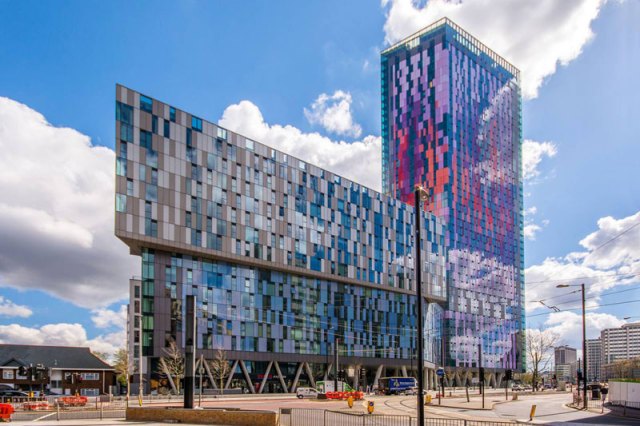Saffron Tower, Croydon, shortlisted in the 2016 Carbuncle Cup. Credit: Wikipedia.

The Nobels, the Oscars, Pipe Smoker of the Year: glittering prizes all, but I prefer the Carbuncle Cup, which is awarded annually to the “the ugliest building in the United Kingdom completed in the last 12 months”.
Organised by the magazine Building Design, it has (in my aesthetic judgement) produced a worthy shortlist and a worthy winner every year since its inception in 2006.
But there’s a big problem with the prize — not its subjectivity, but the fact that the winning buildings still exist. Indeed, buildings like them are still being built. Name-and-shame is not working.
There’s an argument to be made that things are getting worse. We’ve swapped the horrendous, but interesting, brutalism of the post-war period for the offensively bland spreadsheet architecture of the 21st century. In an age in which Jane Jacobs has won the intellectual battle against Robert Moses, we really ought to know better. Yet we continue to fill up our towns and cities with inhumane, alienating architecture.
It’s environmentally destructive too. For instance, around Victoria Street in London you see buildings that went up within living memory now being demolished and replaced. Though that’s no great loss to our heritage, it can’t be sustainable to throw-up these great piles of concrete, glass and steel only to tear them down again a few decades later. Is it not too much to ask our architects to design buildings that won’t just enhance our lives, but also outlive us?
It might seem paradoxical, but to end the cycle of destruction, we need to accelerate it. Every year, there should be a public vote to choose the worst new building in the land. The winner wouldn’t get a cup, but a wrecking ball. Yes, that’s right, it would be physically demolished — immediately and without compensation. Indeed, the owner would be required to foot the bill for the building’s de-construction (though they would have the option of suing the architect and the planning authority).
This would concentrate minds wonderfully. Instead of competing among themselves to épater les bourgeois, starchitects would need to design with due regard to the common good. Meanwhile, developers whose sole objective is to squeeze as much profitable square footage into any site they can get their hands on, would have to contend with the possibility of financial (as well as literal) ruin. The planners would come under immense pressure to do a better job too. At the cost of sacrificing one new building, development across the land would be greatly improved.
There’d be a minimum threshold of votes required to trigger a compulsory demolition, so by achieving a broad consensus behind new development — not least by properly involving local people in a positive planning and design process — it’s possible that no new building would have to come down.
But can the people be trusted? By placing the wrecking ball in their hands, would we imperil innovative projects that shock a lot of people at the time that they’re built, but come to be loved? Here I don’t mean the concrete monstrosities that sophistication-signallers like to rave over on Twitter, but genuine wonders like the Eiffel Tower.
We could, perhaps, complement the vote-to-demolish with a vote-to-save, but beyond that I am inclined to trust the people. Indeed, radical democratisation would do more good than harm, freeing architecture from the stifling conformity imposed by elite taste-makers and those who pay for their work.
If there is a flaw in my modest proposal it’s that the focus would be on the tallest, flashiest new buildings — and therefore London. The problem isn’t that these aren’t crap, but that less prominent crappiness in other parts of the country might get overlooked. The prize therefore should be regionalised, with categories for a different scales and types of development. After all, we don’t just need well-designed, sustainable landmarks but also beautiful houses, shops and other everyday buildings.
Some of you might think that I’m ignoring the real objection to my idea — which is that the state can’t go round demolishing newly-built, structurally-sound private property. But it can and sometimes does. You could build a brilliantly-designed dwelling in an area that desperately needs more homes, but if you do so without planning permission, it’ll be knocked down. That’s the law.
Admittedly, my idea concerns buildings that have got planning permission. But that’s precisely the point: the planning system as it stands is failing. Over-and-over again it stops the development we do need while allowing development that makes places worse. Despite recent reforms, the system remains opaque, important decisions are made behind closed doors and the whole process advantages the rich and powerful over ordinary people.
Unlike bad art or bad literature, bad architecture is something that whole communities are forced to live with. Our existing laws clearly doesn’t provide them with the protection they need, so we must redress the balance. I’d prefer it if we could move to a fully democratic, consensus-based planning system, but that won’t happen unless the developers, and the financiers behind them, are incentivised to make it work.
My proposal provides the incentive. I’ll admit it does so in a brutal, uncompromising manner, but fans of modernism should surely approve of that.










Join the discussion
Join like minded readers that support our journalism by becoming a paid subscriber
To join the discussion in the comments, become a paid subscriber.
Join like minded readers that support our journalism, read unlimited articles and enjoy other subscriber-only benefits.
Subscribe